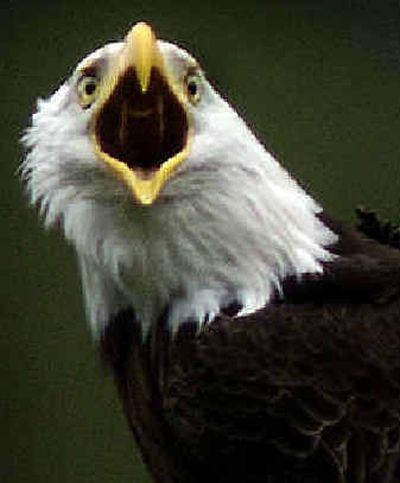Eagles gather in record numbers for Lake Coeur d’Alene fish feast

It’s a record year for bald eagle watchers at Lake Coeur d’Alene.
U.S. Bureau of Land Management biologists counted 156 eagles in the Wolf Lodge Bay area Thursday. That’s 13 more than last year’s record count of 143, and 40 birds greater than last week’s count of 116, said BLM biologist Scott Robinson.
The birds congregate each year from November into January to feast on kokanee salmon that pack into the northeast corner of the lake for spawning.
The number of eagles flocking to the lake is expected to peak around Christmas, when eagle watchers traditionally flock to the lake, too.
By nature’s standards, this is a relatively new event. Kokanee were introduced to Lake Coeur d’Alene in 1937, and soon after they started showing up each fall in spawning areas, particularly Wolf Lodge Bay, bald eagles started taking notice as though a new bargain restaurant had opened on their southward migration route.
The number of eagles congregating at the lake has been steadily growing in recent years. But as soon as the bay freezes or the kokanee complete their spawning cycle and the smorgasbord dwindles, the eagles continue south, mostly to the Klamath Basin of Oregon and California, or into southern Idaho and Utah, said Phil Cooper, spokesman for the Idaho Department of Fish and Game.
Eagles aren’t picky. They’ll eat all sorts of prey on their way, particularly roadkill.
Bald eagles have a wingspan up to seven feet. Males weigh 8-10 pounds; females are larger, at 10-14 pounds.
The white head of the adult eagle – male and female alike – is usually the first thing that catches a birdwatcher’s eye as the eagles perch in trees and snags along Lake Coeur d’Alene and area rivers. Young bald eagles have a brown head until they mature at age 4 or 5.
After a storm that leaves snow in the trees, the bald eagles are much more difficult to spot, said Robinson, who conducts BLM’s weekly eagle counts.
“The daily life of an eagle in Wolf Lodge includes a dawn flight from a nightly roost over a mile away,” Cooper said. “Feeding activity begins upon arrival at the lake and continues throughout the early morning. Eagles will locate a fish from the air or a perch, glide over the water, and grab the fish with sharp talons. Returning to a feeding perch in a tree, the eagle tears pieces off with its beak to eat the fish.”
Feeding slows at midday, resuming in late afternoon before they fly back to their roosts.
“The bald eagle is probably the most widely recognized symbol in the United States,” Cooper said, noting that it first appeared on a coin in 1776 and beat out Benjamin Franklin’s favorite — the wild turkey – to officially become our national symbol in 1782.
The bald eagle is unique to North America, with concentrations in the Pacific Northwest, Alaska, western Canada, the Great Lakes, the Mississippi River and the Atlantic Coast.
The Bald Eagle Protection Act of 1940 prohibited killing of eagles and first protected the species’ habitat, Cooper said.
“In 1978, the Endangered Species Act listed bald eagles as endangered in 43 states and threatened in five states; providing further protection. Reduced direct killing of eagles and the banning of certain pesticides have enabled eagles to exhibit dramatic recovery.”
Bald eagle nests in Idaho have increased from 11 in 1979 to more than 100, with about 30 in the Panhandle, Cooper said.
Bald eagles were removed from the endangered list and listed as threatened in 1995.